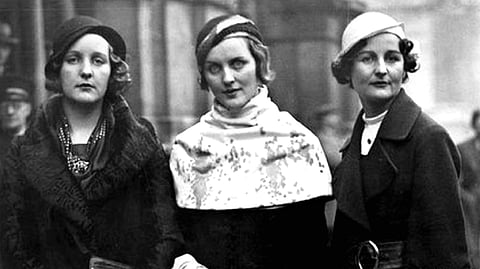

WASHINGTON: Anyone trying to dive deep into the history of British far-right and fascist movements in the 1930s is bound to come across the names of Unity Mitford and Oswald Mosley.
Rumored to have been Hitler’s girlfriend, Unity Mitford’s personality and ideas have been discussed in books such as David Pryce-Jones’ “Unity Mitford: An Enquiry into Her Life and the Frivolity of Evil” (1977). Now a new book on the topic, “Hitler’s Girl: The British Aristocracy and the Third Reich on the Eve of WWII,” has been published. The author, Yale lecturer Lauren Young, has used newly unclassified material for the work.
By revealing the complicity of British aristocrats with Hitler’s Germany and the possible threat to British democracy at the time, Young aims to demonstrate how Western liberal democracies face the same challenges today as in the 1930s.
“We are inundated with information about the Second World War, Hitler and the Nazis. This book argues that today’s challenges to democracy are similar to those of the 1930s,” Young tells DW. The author and lecturer has previously taught at the London School of Economics and served as a political adviser in many international forums, including the UN.
The book first establishes the historical background by chronicling how Germany’s crushing defeat in World War I and the severe terms of the Treaty of Versailles led to financial and social crises in the country, setting the stage for Hitler’s rise to power.
Young then looks into how the British aristocracy started flirting with fascism as early as the 1920s, when members of the upper class, including the Duke of Westminster, the Duke of Buccleuch and politician Harold Nicolson traveled to Italy to observe the fascist movement for themselves.
Winston Churchill, who later became Britain’s prime minister, had also visited Italy during this period, leaving the country with a favourable impression of the fascists as an “antidote to the Russian poison,” according to the book. Young also examines the emergence of the British Union of Fascists, led by Oswald Mosley, and discusses how many members of the aristocracy, including Unity Mitford’s family, were connected with it. The author points out that pro-Nazi views were also found among the royal family. She mentions a 1933 video of the late Queen Elizabeth II, who was seven years old at the time, giving the Nazi salute along with her mother and her younger sister, Margaret, as instructed by their uncle, future King Edward VIII. The publication of the picture in 2015 in British tabloid The Sun caused a furore and a dismissive response by the royal family. The book also mentions aristocrats like the Duke of Connaught and the Earl of Kincardine showing interest in visiting a concentration camp in Germany to understand how the Nazis were implementing “race purity and fitness.”
It also discusses how the cornerstone of Neville Chamberlain’s foreign policy was to avoid war at all costs, and this included an unspoken rule to refuse German and Austrian Jewish refugees entry into what was then British-mandated Palestine. Chamberlain, who had preceded Churchill, was British Prime Minister from 1937 to 1940. Even the Kindertransport to Britain could have been more robust and saved more Jewish children, had the British government been less eager to please Hitler, the author argues.
Visit news.dtnext.in to explore our interactive epaper!
Download the DT Next app for more exciting features!
Click here for iOS
Click here for Android